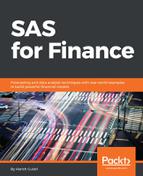Like most analysis, insights generated should be used after a conceptual understanding of how the analysis has been generated. The sequence plays an important role in the analysis. If, for instance, we conclude that customers with a personal current account are more likely to open a savings account, we are implying a sequence. This is easier to infer in a two-product set size. However, for a three-product set size, the insight statement might be misleading. When a customer has a personal current account and savings account, the customer is likely to take out insurance. In this instance, the right-hand side (RHS) of the rule is the savings account. The left-hand side (LHS) rule is a combination of the two products. If we assume that a personal current account is the first condition to adhere to in the rule, we could be wrong. Some procedures/macros (pre-written in SAS or frequently used by analysts) ignore the sequencing of the products or services. In the preceding instance, when a sequence is ignored, the rule might simply state that as long as the two products from the LHS of the rule are present in a customer's basket, the customer is likely to avail themselves of the third product from the RHS of the rule. In the analysis presented in this chapter, the sequence has been taken into consideration.
MBA could suffer from how products and services have been traditionally sold in an organization. A salesperson might say all my customers are readers of the Daily Telegraph. Well, this might be the case if the product was only advertised in the Daily Telegraph. There could be an inherent bias in the way the products and services are advertised and sold, and this could manifest itself in the insights generated. For instance, external regulations or bank policies may stipulate that to trade stocks and cryptocurrency using a trading account, a customer will have to open a current account with the same bank. In this instance, a rule stating that a basket with a trading account is likely to have a current account at some point in time is meaningless.
Most marketers will dismiss the insight that having a current account is likely to lead to the opening of a savings account. There could be some baskets that generate insights that could be meaningless from an execution perspective. As with any other analysis, the analyst should be aware of false positives and should always discuss with the relevant teams to ensure insights are relevant.
The MBA code using inbuilt procedures is fairly short in SAS. However, it isn't available in most SAS versions and definitely not in the SAS University Edition, which has been widely used in this book. Taking this as an opportunity, the detailed code will be shared in this chapter. The code uses commonly available SAS procedures and functionalities to explain the steps involved in executing the analysis and extracting meaningful insights. The code refrains from using complex programming steps, and hence should be fairly easy to understand for users with limited SAS knowledge. Some readers may find that the code can be shortened by using complex joins and arrays. However, for the benefit of all readers, the code has been simplified.
